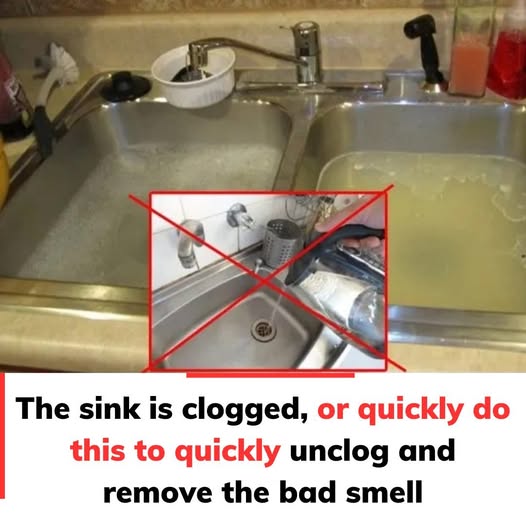ADVERTISEMENT
Step-by-Step Guide to Unclogging Your Sink:
- Remove any standing water: If your sink is full of water, start by removing as much as possible. You can use a cup or small container to scoop it out. This will allow the baking soda and vinegar to work directly on the clog.
- Pour in the baking soda: Take the baking soda and pour it directly down the drain. Use about 1 cup for most household sinks. The baking soda will help break down any grease, grime, and soap scum that may have built up in the pipes.
- Add the vinegar: After the baking soda, pour in 1 cup of white vinegar. You’ll notice a fizzy reaction, which is exactly what you want. The fizzing helps to loosen up any debris and break down the clog, while also eliminating bad odors.
- Cover and wait: If possible, cover the drain with a wet cloth or plug to keep the fizzing action inside the pipes. Let the mixture sit for about 10-15 minutes. This gives the baking soda and vinegar enough time to break down the buildup.
- Flush with hot water: After waiting, carefully pour 2 cups of hot water down the drain. This helps to flush out the debris and clear the clog. The hot water also helps wash away the vinegar and baking soda residue, leaving your sink fresh and unclogged.
- Plunge (if necessary): If the sink is still clogged after the fizzing and hot water, grab a plunger and give it a few firm plunges. This can help dislodge any remaining buildup. Be sure to cover the overflow hole (if your sink has one) with a wet cloth to create a better seal.
Step 7: Enjoy a Fresh Sink!
Once the water flows freely again, you’re done! You’ve not only cleared the clog, but you’ve also neutralized any bad odors that were lingering in the drain. You can repeat this process once a month to keep your drains clean and fresh.
Additional Tips to Prevent Clogs and Bad Smells
- Use a drain catcher: To prevent hair, food, or other debris from entering the drain, consider using a drain catcher or strainer. This will help keep larger particles out of the pipes and prevent future clogs.
- Avoid pouring grease down the drain: In the kitchen, never pour grease or oil down the sink. These substances solidify in the pipes and cause clogs. Instead, dispose of grease in the trash or compost bin.
- Rinse with hot water regularly: Regularly flushing your sink with hot water helps keep soap scum, grease, and mineral deposits from building up in the pipes.
- Deep clean your sink once a week: Give your sink a weekly deep clean by scrubbing it with a mixture of baking soda and water. This will help maintain a fresh and odor-free drain.
- Use a natural deodorizer: After unclogging the drain, you can sprinkle baking soda down the drain and let it sit for a few hours to absorb any remaining odors. Flush with hot water afterward to clear it out.
Why Choose This Method?
- Safe and natural: No need for harsh chemicals that can damage your pipes or harm the environment.
- Cost-effective: Baking soda and vinegar are affordable and readily available in most households.
- Effective: This method tackles both clogs and odors in a single step, leaving your sink clean and fresh.
Conclusion
A clogged sink doesn’t have to be a headache. With just baking soda, vinegar, and hot water, you can quickly and easily clear the clog and get rid of the bad smell. Not only does this method work wonders for most clogs, but it’s also safe for your pipes and the environment.
So, next time your sink is backed up, skip the chemical drain cleaners and reach for these household staples to restore your drain to its former glory!
ADVERTISEMENT
